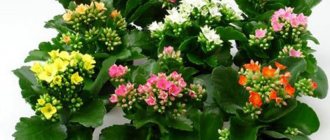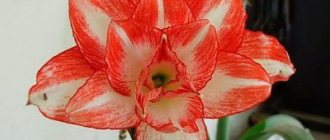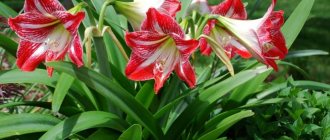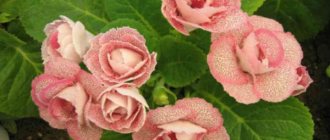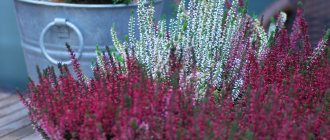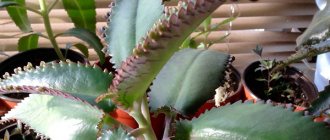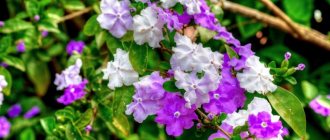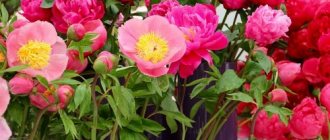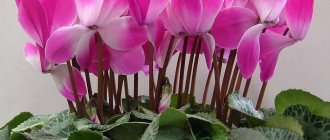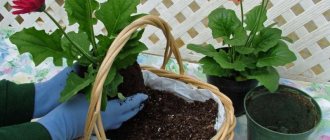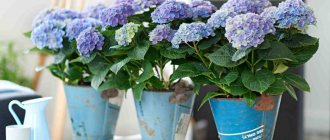Origin and appearance of the Dendrobium nobile orchid
The perennial herbaceous plant Dendrobium nobile belongs to the orchid family. Its second name, Noble Orchid, describes this wonderful flower as accurately as possible.
The lovely Dendrobium nobile orchid is a worthy representative of the orchid family
Like most representatives of the orchid family, Dendrobium nobile came to us from Asia. India, Bhutan, Assam, the Himalayas, Thailand, China - this is not a complete list of countries where this plant is found.
The translation of the name of this genus of orchids - “living on trees” - speaks for itself. These orchids lead an epiphytic lifestyle - they grow on other plants or are permanently attached to them. Dendrobium nobile grows in deciduous and evergreen tropical forests. But there are also lithophytes decorating the harsh, moss-covered rocks.
Dendrobium nobile - epiphytic plant
Dendrobium nobile has a sympodial type of growth: from erect pseudobulbs, divided into segments, a thick, succulent stem up to 90 cm high is formed. At first green, the pseudobulb turns yellow and dies towards the end of its life (after about 4 years). But before that, babies are formed at its top, giving life to new plants.
Appearing in Europe in the 19th century, the plant instantly became incredibly popular. On its basis, new hybrids immediately began to be developed, which in our time can no longer be counted. For this reason, you won’t be able to find a real Dendrobium nobile orchid in the store.
Large, up to 9 cm in diameter, flowers have a waxy texture. The color is varied - white, yellow, orange, deep purple. A distinctive feature of Dendrobium nobile hybrids is the special arrangement of peduncles. They are formed not at the top of the pseudobulb, but along its entire length. Inflorescences consist of 1 – 3 flowers. And the entire pseudobulb can be decorated with 70 flowers at the same time.
Dendrobium nobile orchid flowers come in a variety of colors.
Growing and care
Depending on their ecology, Dendrobiums are cultivated in rooms with moderate (18–22°C) or cool temperatures in baskets, on blocks of cork oak bark or tree fern roots. The substrate for their cultivation is pine bark, rotted leaves, charcoal and sand (1: 1: 1: 0.5).
Deciduous Dendrobiums, originating from areas with a monsoon climate, have a pronounced dormant period. In spring and summer they are kept in a warm (22–24) humid environment, preferably in a greenhouse. After the stems ripen, watering is reduced, and in winter it is stopped altogether, limiting itself to only occasional spraying and maintaining the temperature at least 15–17 degrees. Dendrobium phalaenopsis, since it does not have a dormant period and comes from tropical rain forests, needs uniformly warm and humid content all year round. In general, the plants are light-loving, however, in hot midday hours they need light darkening. They grow better in small containers.
Propagated by dividing the bush, stem cuttings and apical shoots - children that form aerial roots. Bushes should be divided no more than every 3-4 years, while apical shoots can be removed annually. Transplantation and propagation are carried out in April - June, depending on the species, when young shoots begin to grow.
Dendrobiums are light-loving plants that prefer fresh air, but do not tolerate drafts. They bloom profusely, on average for 12–19 days. When cut, the flowers of some species remain fresh for 4–6 days (for phalaenopsis dendrobium - up to 3 weeks).
Feed during the period of intensive growth 2 times a month with a 0.01% solution of complete mineral fertilizer.
After growth has finished, deciduous species enter a dormant period and need to be kept cool and dry. Species without a clearly defined dormant period, such as D. moschatum, require minimal watering when growth processes die out. Tropical species (D. phalaenopsis, D. chrisotoxum) require watering at any time of the year, and the minimum temperature in winter should not be lower than 15°C. During dormancy in the greenhouse, a certain air humidity should be maintained at all times, and the plants should be sprayed periodically to avoid excessive depletion and wrinkling of the tuberidia.
All types of Dendrobium orchids need a small container. Many species are also suitable for breeding on blocks. Tall plants need to be sprayed more often to prevent pest damage. Some species of Dendrobium, for example, phalaenopsis, are prone to the formation of “babies”, which are easy to propagate these species.
Noble Dendrobium (Dendrobium nobile), as well as other species and hybrids that shed leaves, should be placed in a cool (10-14°C) and dry place in the dark season (from November to January). Once the buds are clearly visible, return the plant to its normal location.
King Dendrobium (Dendrobium kingianum), magnificent Dendrobium (Dendrobium speciosum) and their relatives in the summer, like orchids of the genus Cymbidium, can be placed in the open air, in a bright but not sunny place
If you do not have this opportunity, pay special attention to ensuring that the plant is in a cool and dry place in winter.
It is enough to place Dendrobium phalaenopsis, as well as related species and hybrids, in a warm place and make sure that the temperature drops at night, as required by plants of these species.
Advice: When purchasing a plant of the Dendrobium genus, you definitely need to find out which temperature zone your orchid belongs to, since due to the wide variety of Dendrobium species, it is impossible to give general advice on caring for the plant.
Keeping at home
Caring for and propagating Dendrobium nobile at home is not particularly difficult. But this, of course, is compared with the complexity of maintaining other species of the orchid family. Indeed, there is no need to shake over Dendrobium nobile and, as they say, blow off specks of dust from it. But you need to clearly understand that an orchid is not a simple-minded geranium, but an exotic plant that requires increased attention and strict adherence to the rules of care. A florist who takes Dendrobium nobile into his home is obliged to create an environment for the orchid that is as close as possible to its natural habitat.
Compared to other orchids, Dendrobium nobile is not such a capricious orchid.
Care
Caring for a dendrobium orchid at home is not so difficult - it’s just important to take into account a few important points
Watering
When the orchid begins its active growing season, it should be watered twice a week, waiting for the soil to dry completely. The drying speed, by the way, depends not only on the temperature in the room, and not even on the size of the container in which the dendrobium is placed. If moisture accumulates in the tray, it should be drained, since the roots of the plant do not tolerate excess moisture well. The water should be soft, slightly warm, ideally filtered. If the flower begins a dormant period, then the amount of irrigation should be reduced to a minimum.
It is more successful to use the soaking method, accompanied by top watering of the soil from a watering can. Everything is done as follows: take a vessel whose volume exceeds the volume of the flower pot and fill it with water. The orchid is placed there for about half an hour, although the larger the pot, the longer it will need to be soaked. After the above time, the excess water is drained, and the orchid returns to its usual habitat. Additionally, it is recommended to blot the sinuses of the leaves with a napkin, as they may rot, especially if the ambient temperature is quite low.
Top dressing
When fertilizing the dendrobium orchid, it is important to dilute any solutions, halving the concentration, since its root system is highly sensitive. Those varieties that do not need a dormant period can be fed once a month with a special potassium-phosphorus fertilizer
If the variety requires wintering, then the frequency of applying fertilizer increases to a couple of times a month, and during the dormant period, feeding stops altogether. In this case, nitrogen-containing compounds are used.
Many gardeners supplement their usual fertilizer complexes with succinic acid, which is an organic biostimulant. Being a non-toxic substance, the acid increases the plant's resilience, its ability to withstand adverse environmental conditions, and also to recover during quarantine or after transplantation. Succinic acid is used in the form of a solution, which can be purchased at a specialty store in spray format.
As an alternative, you can take a tablet of succinic acid and simply dissolve it in a liter of water. The resulting solution can be used to treat the orchid for three days - during this period it will not lose its beneficial properties.
Trimming
Trimming the pseudobulb of an orchid is carried out after it has completely dried, symbolizing that the flower has been able to derive maximum benefit: to receive both useful substances and liquid. As for the peduncle, you should not cut it off while there are buds left that can bloom. An exception may be when the stem dries out, but in this case at least a minimal stump is still left.
Advantages and disadvantages of an exotic flower
Among the advantages of this orchid, flower growers note its beauty, variety of shapes and colors, pleasant aroma, and long-lasting flowering. And, of course, its character is not capricious compared to other orchids.
Among the disadvantages is intolerance to dry air, which complicates the care of Dendrobium nobile at home in apartments with central heating.
One of the undeniable advantages of Dendrobium nobile is its colorful flowering.
How to water?
When the flower is actively growing, it is watered abundantly every 3-4 days. Water accumulating in the pan is removed so that there is no stagnation, which causes rotting of the roots.
When the Dendrobium Nobile orchid is in a dormant period, it is watered only when the substrate is completely dry and the roots become light green in color. In winter, Dendrobium, which sheds its leaves, can be left without watering.
When the plant decides to bloom or form shoots, watering is resumed.
The flower immersion method has proven itself well.
The pot with the orchid is placed in a deep tray with warm water for 10-30 minutes and water is poured from above onto the substrate using a watering can. When the bark is saturated, the pot is removed from the water and the moisture is allowed to drain. Places where water has stagnated are blotted with a napkin, because caring for leaves means caring for both the health of the flower and its appearance.
Hybrid Dendrobiums do not survive a dormant period. As soon as a young sprout has formed, they immediately bloom. Only in winter, when there is less light, the flower enters the dormant stage.
While the orchid is in a forced period of rest, it is not watered or fertilized. The temperature is kept within 20 °C.
As soon as the roots begin to grow, young shoots appear and flower stalks develop, care takes on the usual regimen.
The Dendrobium orchid experiences the following growing seasons:
- From March to June – rapid growth of pseudobulbs and leaves;
- From May to September – root development;
- From September to February – a period of rest;
- From February to May is the flowering period.
Once the Dendrobium orchid has finished blooming, you can replant it.
What to do when caring for an orchid at home
Caring for Dendrobium nobile is not as difficult as some other types of orchids, but the plant requires strict adherence to the basic rules.
An orchid will live and bloom with proper watering.
First, let's talk about the quality of the liquid. The water should be soft and filtered. You can use boiled and cooled. Its temperature should be several degrees above room temperature.
Each apartment has its own microclimate, so under different living conditions it is impossible to establish clear rules for watering: the gardener must focus on the level of illumination and temperature of his home. The hotter it is, the more generous the watering should be, and, conversely, as the temperature drops, the intensity of moistening decreases.
Spring and summer watering differs in abundance, but not frequency. The bark that fills the pot must dry completely before watering again. In winter, water very carefully to avoid rotting of the roots.
The ideal method of moisturizing still remains the immersion method, when the pot with the plant is immersed 1/3 in a container of water so that the roots and substrate are thoroughly saturated, then the excess moisture is allowed to drain.
Many gardeners recommend regularly bathing the orchid under a hot shower, the temperature of which is from 40 to 45 ° C. This procedure not only cleanses the leaves, helping to improve gas exchange in the tissues, but also stimulates flowering. Be sure to blot water in the axils of the leaves after showering to avoid rotting.
It is best to water Dendrobium nobile using the immersion method.
How much should you fertilize?
Since the orchid grows in poor soil, it must be fertilized, but only at a certain time. Feeding begins in the spring, when active flower growth resumes, and continues during the flowering period. You should never forget how much and what kind of feeding Dendrobium Nobile needs. Only use fertilizers intended for orchids. Their rate is reduced by half from that indicated in the instructions. Fertilizers are applied at every 3rd watering. Foliar fertilizing with a highly diluted fertilizer will also not be superfluous. By alternating these methods, you will help the plant absorb nutrients as much as possible.
Dendrobium nobile has one peculiarity. In spring, not only growth buds awaken, but also flower buds. The passion for nitrogen fertilizers will lead to the formation of a large number of children, but you may not wait for flowering. Therefore, when the sprouts reach almost half their size, abandon nitrogen-containing fertilizers in favor of those that include phosphorus.
Video: how not to fertilize a plant
Preparing for flowering
Dendrobium nobile blooms at different times of the year, this is due to the incredible number of hybrid forms. The flowering period takes a month, sometimes a little more. Its duration directly depends on the air temperature of the room in which the plant is kept. The higher it is, the sooner the orchids will bloom. The ideal temperature for flowering is 18 C.
Sometimes an orchid refuses to bloom. Why? This happens if you do not pay attention to the plant’s requirements for living conditions. If you maintain the correct combination of lighting, temperature and watering parameters, then no problems with the development of flower buds will arise.
- Starting in spring, lighting should be as bright as possible.
- The temperature during the day is within 25 C and no higher, at night it is 3–5 C lower, otherwise the flower buds will degenerate into growth buds.
- Watering abundantly, with good drying of the substrate.
- Don't overdo it with fertilizers. Increased concentration can harm the roots.
After flowering, all flower stalks are removed. If there is a need for a transplant, do it. Do not water the orchid for several days after transplantation to prevent the possible development of rot on the roots.
And most importantly, after flowering, the orchid must undergo a period of rest.
Do not rush to remove old yellowed pseudobulbs. They will serve as food for young growing shoots. You can cut them only after they are dry. Don't forget to sprinkle the cut area with crushed coal.
For Dendrobium nobile to bloom actively, it needs a lot of light.
Video: Careful care will make an orchid bloom
How to care when the dormant period has begun
Dendrobium Nobile is a cyclical plant. It is necessary to create such conditions for the orchid so that it goes through all the cycles of its development provided by nature. The dormant period is very important for the flower. It is at this time that it accumulates strength and begins preparations for the next flowering.
In our climatic conditions, Dendrobium nobile is forced to go into winter dormancy. This occurs due to a decrease in light intensity.
- The plant must be taken into a room with a daytime temperature of 15–16 C, and a night temperature of 10–12 C.
- Watering stops. If the pseudobulbs begin to wrinkle, you can lightly spray the substrate and leaves.
- There is no need to specifically maintain humidity around the plant during this period.
- After 2–3 weeks, flower buds should appear in the internodes of the pseudobulb.
After flowering, the orchid should rest
Flowering periods for different species
| View | Period |
| Crowded | March-May |
| Crisantum | May-September |
| Golden | December-April |
| Fringed | March-May |
| Noble (Nobile) | January-April |
| Parisha | May June |
| Phalaenopsis | September-January |
| Vardianum | April June |
| Berry Oda | July-September |
IMPORTANT: The flowering periods indicated in the table are approximate. Depending on the specific growing conditions, they can move up to 1-2 months.
Table: seasonal requirements of the Noble Orchid for living conditions
| Season | Lighting | Humidity | Temperature |
| Summer | Bright, but without direct sunlight | Watering abundantly, but with drying the substrate, the plant needs increased air humidity. | During the day: +25 C, at night: 3–5 degrees lower |
| Winter | Moderate | Humidity is moderate. During the dormant period, watering stops altogether. | During the day: +15–16 C, at night: +10–12 C |
Why don't they appear?
Sometimes orchids of the Dendrobium genus can go dormant for a long time and not bloom for up to 10–12 months in a row. This is usually due to the following factors:
- Drying out or, conversely, rotting of the roots from excessive watering and stagnant water.
- The plant does not have enough light.
- Insufficient rest period. This is not so bad for hybrids (such as Nobile or Berry Oda), but even these require a period of rest.
- Acclimatization. Often, when purchased, an orchid stops flowering, sheds its petals and begins to form “babies” - pseudobulbs. This means that the plant responds to changes in microclimate.
You will learn about the varieties of dendrobium orchid and its hybrids in this article, and also read in more detail about the species Nobile and Berry Oda.
Table: the most common care errors and their elimination
| Error | How it manifests itself | Elimination |
| Dry brown spots on leaves | Sunburn | After spraying, do not expose the leaves to direct sunlight (especially through window glass). You need to gradually accustom your orchid to the sun |
| Weeping, rotting spots on leaves | Spraying at low temperatures | Avoid spraying if the air temperature is below 20°C. In such conditions, moisture evaporates very slowly, and conditions favorable for the development of gray rot are created. |
| The lower leaves turn yellow and fall off, but the orchid looks healthy | The natural aging process of sheet plates | Don't worry: the leaf lives no more than 2 years |
| The base of the leaf rots | Water entering leaf axils | After spraying and showering, remove water from the leaf axils with a napkin. |
| Dendrobium refuses to bloom | Not enough light. The rest period was not observed | Dendrobium Nobile is the most light-loving orchid. Without sufficient lighting and a period of rest, the plant will not bloom. |
Why are changes happening?
Most of them are associated with improper care of the crop, so to maintain the health of the plant, you need to determine exactly what caused the pathology and review the rules for caring for the flower. There are five common situations in which leaves change color.
Aging
Often an orchid begins to bloom only 2-3 years after planting , by which time the plant has already formed true leaves. The aging process begins to affect the lower part of the plant, that is, those leaves that grew first. At the same time, the flower itself is in a healthy condition and has an attractive appearance and continues to bloom. If the leaves turn yellow during the aging process, then there is no need to worry and do something, the leaf will gradually dry out and fall off.
Table: diseases and pests characteristic of Dendrobium nobile
The best prevention of Dendrobium Nobile against diseases and pests is proper care.
| Diseases and pests | Symptoms | Treatment measures | Prevention |
| Root and stem rot is a fungal disease caused by frequent waterlogging of the soil. | The plant looks drooping. Leaves and pseudobulbs become covered with weeping brown spots. | The plant needs urgent replanting. Remove old substrate. Trim damaged areas of roots and leaves. Sprinkle the wounds and healthy roots with crushed coal and dry. If the damage has severely affected the orchid, the plant must be treated with the biofungicide Mikosan. Plant in new soil mixture. Don't water for a couple of weeks. | Adjust your watering schedule based on the conditions in which the orchid grows. Water only after the soil is completely dry. |
| Thrips | Small winged insects located on the underside of leaves. Damaged leaves turn brown and fall off. The edges of the flower petals look dried out. | Spray the orchid with a solution of Aktara insecticide (4 g per 5 liters of water). If the plant is heavily infected, the treatment should be repeated after 2 weeks. You can use Actellik (2 ml per 2 l) of water. For minor damage, 1 spray is enough; for severe damage, repeat after 15 days. The drug is toxic; personal protective equipment must be used. Drugs can be alternated. | The leaves are cleaned from insects with a napkin soaked in a soap solution, which has an antiseptic and disinfectant effect. Regularly bathe the orchid in the shower. Spraying the plant with garlic tincture. |
| Aphid | Aphids can colonize a flower very quickly. Entire colonies of pests actively suck out cell sap, which is why the orchid's leaves become deformed, turn yellow and die. | ||
| Shchitovka | Sap-feeding insects hide under brown shells. A weakened plant's leaves turn yellow and dry out. | ||
| Spider mite | Leaves and shoots covered with cobwebs are the main sign of the pest. By piercing a leaf, it leaves many small spots, which then merge into large ones. Affected leaves and flower stalks die. |
Photo gallery: recognize pests and diseases
Root rot occurs from frequent waterlogging of the substrate
Leaf of an orchid affected by thrips
At home, aphids often infest the orchid.
Scale insect on an orchid leaf
Spider mites entwine young shoots with the finest cobwebs
Pests
Often flower diseases are provoked by the presence of pests, such as:
- spider mite;
- aphid;
- scale insects;
- thrips.
To combat them, you need to increase the air humidity and treat the plant with a soap solution several times a month.
Insects are removed from leaves and stems by hand if the infestation is small. If the flower is severely affected, then you need to treat it with a special chemical insect repellent.
Reproduction methods
Propagating Dendrobium nobile at home is not so easy. There are 3 proven methods to force an orchid to produce offspring.
Dividing the bush
An adult and healthy Dendrobium nobile orchid with at least 3 pseudobulbs is subjected to this method of propagation. Since the procedure is stressful for the plant, it is carried out no more than once every 4 years, combined with replanting. Divide only after Dendrobium nobile has flowered.
- Before dividing the bush, the orchid's root system needs to be well saturated with water so that the roots become more flexible and pliable.
- Remove the plant from the pot and shake off the substrate. Using a sharpened knife, divide into parts so that each has 2 - 3 pseudobulbs with roots.
- We immediately cover the cuts with crushed coal.
- We leave the cuttings for a day in a slightly shaded place to dry the wounds.
- We plant it in a suitable soil mixture and care for it in the same way as after transplantation.
- New plants will bloom next year.
Dividing the Dendrobium nobile bush
Why is it better to choose cuttings?
This method is considered the easiest.
- To make cuttings, you need to cut off an old pseudobulb without leaves (plant trunk) at the root and cut it into pieces. Each must have at least 1 dormant bud.
- We treat the cut areas with coal dust.
- Place the cuttings in a container filled with damp moss. Cover with a bag or glass to create greenhouse conditions inside.
- We keep the greenhouse in bright, diffused light, regularly moisten and ventilate.
- The root system is formed within 2 - 3 weeks, and the children themselves grow very quickly.
Dendrobium Nobile cuttings are placed on damp moss
When the roots grow 5 cm, transplant the plants into separate pots with fine pine bark mixed with coconut fiber and care for them as you would for adult orchids.
Dendrobium nobile cuttings germinate very quickly
Reproduction by children
Dendrobium nobile produces a lot of babies, including from degenerated flower buds.
Try to keep the babies on the mother plant for as long as possible. This is necessary for the root system to grow.
Children need to be kept on the mother plant until their root system is formed.
When the shoots reach 8 cm in size, they can be carefully separated from the mother plant with a knife.
Separate Dendrobium nobile children with a sharp knife
Treat the cut areas with activated carbon.
After a day, independent young plants can be planted in the substrate.
Fertilizers to stimulate dendrobium flowering
The last factor for good flowering of dendrobiums is sufficient, but not excessive nutrition. It is also organized according to the phases of the plant's life cycle:
| Life cycle phase | Need for fertilizing | Suitable fertilizer |
| Young stem growth | High, nitrogen-dominated | "Agrecol for orchids" |
| Thickening of pseudobulbs | Medium, sparser, weak solution of balanced fertilizer | "Fasco for orchids" |
| The appearance of a peduncle | High, with a predominance of phosphorus and potassium | "Pokon for orchids" |
Some experienced owners of dendrobiums advise, after the growth and thickening of the pseudobulb has stopped, to apply fertilizer to the orchid, prepared according to the following recipe:
- dilute any ready-made special fertilizer for orchids with a balanced ratio of nitrogen, phosphorus and potassium in 1 liter of water according to the instructions;
- add 2 grains of superphosphate to the working solution and feed the orchid at the root.
It has been noticed that such fertilizing stimulates dendrobiums to flower well. During the growth of flower stalks, you can give the orchid this fertilizer one more time, but after the first bud opens, any feeding stops.
Simultaneously with phosphorus fertilizing, it is useful to spray the dendrobium with a solution of boric acid. It needs to be diluted with hot water at the rate of 1 g of powder per 1 liter. After the acid has completely dissolved and cooled, the solution is poured into a finely dispersed spray bottle, and the orchids are processed leaf by leaf. The procedure can be repeated 2 times within a month, but only on the buds and the growing peduncle, before the buds begin to emerge.
Another organic substance, nicotinic acid, also stimulates flowering well. It can also be found under the names vitamin B3, niacin or vitamin PP. To feed dendrobium, buy a pharmaceutical solution of nicotinic acid in ampoules. Next, 1 ampoule is diluted in 1 liter of water, and the working solution is given either over the leaves or by watering over a moist substrate.
Practice shows that the NV-101 vitalizer helps achieve excellent results in terms of flowering of dendrobium and other orchids. It is available in the form of granules or liquid concentrate, but only concentrate is suitable for orchids. It should be added to water at the rate of 2 drops per 1 liter and sprayed on orchids all year round once a week.
You can stimulate orchids to bloom using a “triple cocktail” prepared from the preparations Epin-Extra, Cytovit and Zircon. To do this, dilute 2 drops of each drug in 1 liter of water and spray once a week. However, without good light and the correct temperature and humidity conditions, performance will be low.
How to create an optimal microclimate for a plant
The Dendrobium Nobile orchid is a native of tropical forests. This must be taken into account when creating a microclimate for the plant. The main thing is to remember that it really does not like extreme heat. At high temperatures, the flower sheds buds and leaves. At the same time, heat stimulates the orchid to reproduce - “babies” are formed instead of flower stalks.
Table: how to create optimal conditions for the dendrobium Nobile orchid
| Factor | Recommendations |
| Location | South-east or south-west window. The orchid must be shaded from the bright sun to avoid burns. The room needs to be ventilated regularly, but the Nobile dendrobium does not like cold drafts. |
| Lighting | The orchid is photophilous, but does not tolerate direct sunlight. If the plant is uncomfortable, you can change the lighting angle by turning the pot. When a peduncle appears, this absolutely cannot be done; the plant will shed its buds. If, if necessary, you rearrange the flower, then maintain the same direction of light. The minimum duration of daylight is 10–12 hours. In winter, use special phytolamps for additional lighting. |
| Temperature | During the active growing season - 25–27°C during the day and about 20°C at night. Such a temperature difference is a necessary condition for flowering. In winter, the temperature is lowered to 18–20°C and 15–16°C, respectively. |
| Air humidity | The higher the better. The required minimum is 60%. In the warm season, spray the orchid more often and give it a shower. Make sure that drops of water do not remain on the buds and leaf axils. It is useful to wipe the leaves with a damp cloth or sponge every 2-3 days. In winter, move the plant away from radiators and other heating devices. |
Temperature
Moderate temperatures are optimal for the development of dendrobiums. Active growth best tolerates daytime temperatures in the range of 20-26°C, and night temperatures from 15 to 20°C. Air baths will also have the most beneficial effect. They can be arranged on an open balcony, terrace or in the garden. The nighttime temperature drop will be close to natural for the dendrobium and will have a positive effect on the formation of flower buds and preparation for the winter flowering stage.
In the autumn-winter season, daytime temperatures drop to 12-17°C, night temperatures - to 10-13°C. At the same time, artificial supplementary lighting is carried out and watering is reduced. By observing these conditions, you can count on gratitude in the form of gorgeous flowering.
If the temperature jumps above 33°C, the root system of dendrobiums stops absorbing moisture, and the leaves evaporate intensely, as a result of which the flower may die.
Why does dendrobium stop blooming at home?
Dendrobium is grown for sale using stimulants, which allows for maximum decorativeness. But when it gets into an apartment, the flower does not receive the usual feeding, so it may still bloom once or twice, but at the same time it becomes rarer and the flowers are small.
An important point for orchids to bloom is maintaining their life cycle. When the flower has a cool microclimate in autumn and winter and good intense lighting throughout the year. This is a natural need for orchids, so they live in their natural conditions. Without observing the alternation of seasonality, the dendrobium soon degenerates, flowering stops, and new rosettes are formed underdeveloped, as a result of which the plant dies. The easiest way to create the conditions necessary for orchids is if they are kept in a private house or placed on a loggia.
